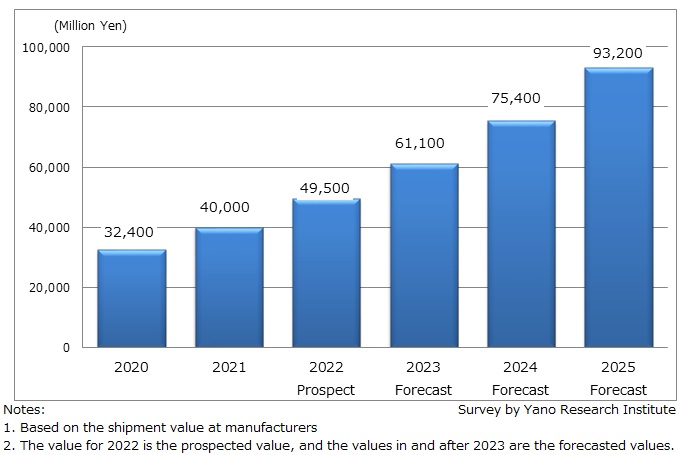No.3081
Global Vapor Chamber Market: Key Research Findings 2022
Global Vapor Chamber Market Projected to Generate 93,200 Million Yen
Yano Research Institute (the President, Takashi Mizukoshi) has carried out a survey on the global markets of vapor chambers, thermally conductive gap fillers, thermal conductive sheets, thermally conductive adhesives/encapsulants/heat-dissipated printed circuit boards, and has found out the market trends by application, trends of R&D institutions, and future perspectives. This paper discloses the global vapor chamber market forecasts.

Market Overview
A vapor chamber is a component to disperse heat, just like a heatsink. Structurally, the heat sink, which is usually packed inside, is converted to a hollow structure, and a volatile liquid is sealed in the empty space. This improves heat dissipation efficiency over heat sinks. The mechanism is as follows: heat from the heat source vaporizes the liquid, the vapor moves through the space to the heat sink side, where the heat is released and returns to the liquid, repeating the cycle.
Although the principle of vapor chambers is generally the same as heat pipes, also a component to disperse the heat, vapor chambers have an advantage of being easy to miniaturize, and has currently become small enough to be embedded in smartphones.
A typical application for utilizing the advantage of a miniaturized vapor chamber is a smartphone. As higher performances in progress for small devices due to start of 5G services, smartphone manufacturers have faced common challenge of how to efficiently disperse heat away from devices, which have led them to adopt vapor chambers as the solution.
The global vapor chamber market size for 2021, based on the shipment values at manufacturers, is estimated as 40,000 million yen, 123.5 % of the size of the previous year. 45.0% of the entire market is occupied by those geared to smartphones.
Noteworthy Topics
Thermal Management Solutions Mainly to Disperse Heat Have Become Significant Issue
Thermal management, mainly heat dissipation, has become more significant for small electronic devices such as smartphones, laptops, tablets, etc., power semiconductor devices, ECUs (electronic control units), and even large industrial machinery. Furthermore, the recent performance improvement in electronic devices has made the heat dispersing designs to be more difficult year by year. Following three reasons are making the designs for heat dissipation for electronic devices difficult:
1) Target cooling temperature is very low.
2) Enhancement of electronic consumption has led to enhancement of heat generation.
3) Heat generation density is very high.
Regarding the first reason, silicon semiconductors used for CPUs for electronic devices are frail to heat, making their operations unstable to function as electronic circuits at around the temperature 120°C. Therefore, the upper limit of operating temperatures must be kept at around 100°C to ensure stable operation, making the heat dissipation designs difficult.
As for the second reason, CPUs and ICs in electronic devices give operating commands to motors, etc. but do not rotate like motors to make other things work. Therefore, most of the energy generated turns into heat. Historically, power consumption of electronic devices has kept on rising, and it doubtlessly rises hereafter, as well.
Regarding the third reason, the more concentrated the energy being generated within compact space, the higher the temperature of heat becomes, although the energy volume is the same. Therefore, as concentration of components within a semiconductor device increases, the heat generation density tends to be higher, which is making the solutions more difficult.
Future Outlook
In order for the electronic components to maintain their functions while generating heat, the designs to quickly disperse the heat through heat-dissipating components are important. Necessity of various thermal conductive components aiming to dissipate heat becomes higher, which makes the global vapor chamber market size to expand to 93,200 million yen by 2025, 287.7% of the market size in 2020. By application, vapor chambers for smartphones are expected to grow the highest, occupying the majority of the entire market.
Research Outline
2.Research Object: Companies producing, selling, and dealing in vapor chamber related products, and R&D institutions.
3.Research Methogology: Face-to-face interviews (including online) by specialized researchers, and literature research
About Vapor Chambers
A vapor chamber is a component for heat dissipation with fluid to be vaporized encapsulated. It offers high performance and is easily miniaturized. It is used as a heat-dissipating component not only for large industrial machinery, but also for small electronic devices such as 5G smartphones and PCs.
<Products and Services in the Market>
Vapor chambers, thermally conductive gap fillers, thermal conductive sheets, thermally conductive adhesives/encapsulants/heat-dissipated printed circuit boards,
Published Report
Contact Us
The copyright and all other rights pertaining to this report belong to Yano Research Institute.
Please contact our PR team when quoting the report contents for the purpose other than media coverage.
Depending on the purpose of using our report, we may ask you to present your sentences for confirmation beforehand.